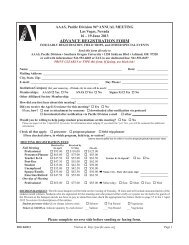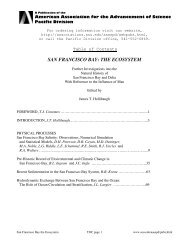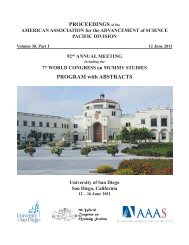Vol 31, Part I - forums.sou.edu ⢠Index page - Southern Oregon ...
Vol 31, Part I - forums.sou.edu ⢠Index page - Southern Oregon ...
Vol 31, Part I - forums.sou.edu ⢠Index page - Southern Oregon ...
Create successful ePaper yourself
Turn your PDF publications into a flip-book with our unique Google optimized e-Paper software.
ABSTRACTS – Contributed Posters<br />
LX-2 human hepatic stellate cell line to test the hypothesis<br />
that TCDD directly affects retinol storage in hepatic stellate<br />
cells, which store the majority of vitamin A in the human<br />
body. LX-2 cells were treated with 5 mM retinol and 100<br />
mM palmitic acid in the presence or absence of TCDD (10<br />
nM). Intracellular lipid droplets were visualized 48 hr later<br />
by staining cells with oil red O. Results indicate that TCDD<br />
treatment abolished lipid storage in LX-2 cells. Additional<br />
studies revealed that exposure to TCDD enhanced LX-2 cell<br />
proliferation and increased markers of activation, such as<br />
expression of alpha-smooth muscle actin and production of<br />
the pro-inflammatory chemokine, monocyte chemoattractant<br />
protein (MCP)-1. However, other activation endpoints, such<br />
as production of collagen 1 and TGF-b1, were not altered<br />
by TCDD treatment. Collectively, these results indicate that<br />
TCDD treatment may directly activate hepatic stellate cells,<br />
leading to the loss of retinol storage and the acquisition of a<br />
pro-inflammatory phenotype. Enhanced activation of hepatic<br />
stellate cells might explain the dysregulation of retinol<br />
homeostasis observed in TCDD-treated rodents.<br />
172 Stress Enhanced Fear Learning Conditioning’s Effect<br />
on Gamma-Aminobutyric Acid Type A Receptors in the<br />
Cortex, RAUDEL HERNANDEZ* 1 , EDWARD MEYER 2 ,<br />
ALEXAUNDREA SMITH 2 , and IGOR SPIGELMAN 2<br />
( 1 Howard Hughes Medical Institute Pre-College Science<br />
Education Program; 2 UCLA School of Dentistry, 10833<br />
Le Conte Avenue, 63-007 CHS, Los Angeles, CA 90095;<br />
l<strong>edu</strong>ar7@yahoo.com).<br />
Gamma-aminobutyric acid type A receptors<br />
(GABA A<br />
Rs), ion channels that control the flow of ions in the<br />
brain, are important drug targets that are potentially altered in<br />
response to stress. Objective: To study changes in GABA A<br />
R<br />
subunits (alpha1, alpha2, gamma1, gamma2 and delta) in the<br />
cortical tissue of an animal model of stress-enhanced fear<br />
learning (SEFL). This animal model mimics human posttraumatic<br />
stress disorder (PTSD). Methods: SEFL rats (n=4)<br />
were conditioned with 15 inescapable foot-shocks (1 mA,<br />
1 second), over a period of 90 minutes. Control rats (n=4)<br />
were not shocked, but spent the same duration of time in<br />
the conditioning chamber. After behavioral measurements<br />
were complete, the cortex was removed, microdissected,<br />
homogenized and assayed for protein concentration.<br />
The cortical tissue homogenate was then run through a<br />
polyacrylmide gel, and transferred to a polyvinyl difluoride<br />
(PVDF) membrane. The membranes were probed with<br />
primary and secondary antibodies, placed into an enhanced<br />
chemilumescent (ECL) substrate, exposed, and developed as<br />
Western blots. This process was repeated for each specific<br />
primary antibody for each GABA A<br />
R subunit. Results: SEFL<br />
rats tended to have slightly more GABA A<br />
Rs subunits in the<br />
cortex compared to control rats, however the difference<br />
were not significant. Discussion: Researching the effects of<br />
stress and anxiety on GABA A<br />
Rs will help medical science<br />
98<br />
understand and potentially treat anxiety disorders like PTSD.<br />
Conclusion: GABA A<br />
Rs are affected by stress and anxiety,<br />
the functional changes in the brain need to be further studied<br />
to identify the mechanisms of how stress induces changes to<br />
GABA A<br />
Rs subunits in the cortex.<br />
173 Stimulation of Adenosine A 1<br />
Receptors in the Nucleus<br />
Accumbens R<strong>edu</strong>ces Dopamine D 1<br />
Receptor-induced<br />
Reinstatement by Antagonizing D 1<br />
-mediated Enhancements<br />
in Glutamate Transmission, BENJAMIN D HOBSON*,<br />
CASEY E O’NEILL, and RYAN K BACHTELL<br />
(Department of Psychology and Neuroscience and Center for<br />
Neuroscience, University of Colorado Boulder, UCB 345,<br />
Boulder CO 80309-0345; Benjamin.hobson@colorado.<strong>edu</strong>).<br />
Cocaine is a psychostimulant that can lead to dependence<br />
following continuous use, resulting in an addiction that<br />
negatively affects the individual’s physical, mental, and<br />
social health. The continuous potential for relapse in addicts<br />
makes treatment of cocaine addiction especially difficult.<br />
These studies seek to understand the neurobiological factors<br />
contributing to relapse using a rodent model of addiction.<br />
Stimulation of either AMPA glutamate or dopamine D 1<br />
receptors in the nucleus accumbens (NAc) is sufficient<br />
to induce reinstatement of cocaine seeking. Identifying<br />
strategies to r<strong>edu</strong>ce the activity of these systems may provide<br />
insight into effective treatments. Adenosine A 1<br />
receptors<br />
co-localize with D 1<br />
receptors on post-synaptic terminals<br />
of medium spiny (NAc) neurons where they counteract D 1<br />
receptor activity through opposing intracellular signaling.<br />
Here, we investigate the interaction between dopamine<br />
and glutamate receptors and explore how A 1<br />
receptor<br />
stimulation in the NAc may r<strong>edu</strong>ce D 1<br />
-induced facilitation<br />
of AMPA receptors and cocaine seeking. Specifically,<br />
we investigate the role of AMPA receptors in D 1<br />
-induced<br />
reinstatement using viral-mediated gene transfer to bidirectionally<br />
modulate AMPA receptor activity in the NAc.<br />
We also determined whether stimulating A 1<br />
receptors in the<br />
NAc would inhibit D 1<br />
-induced reinstatement and GluA1 S845<br />
phosphorylation using a synaptoneurosome prep and<br />
subsequent western blot analysis. Our results demonstrate<br />
that stimulation of A 1<br />
receptors decreases D 1<br />
-induced<br />
cocaine seeking as well as GluR1 S845 phosphorylation. These<br />
findings suggest that A 1<br />
receptor stimulation r<strong>edu</strong>ces the<br />
activity dependent AMPA receptor trafficking that drives D 1<br />
receptor-mediated reinstatement.<br />
174 Investigating the Interaction of Osteogenic Cell Sheets<br />
with Osteoblast Cells, EDWIN SALVATIERRA 1 *, RAJITA<br />
KODALI KANURU 2 , and OGAWA TAKAHIRO 2<br />
( 1 Howard Hughes Medical Institute Pre-College Science<br />
Education Program, UCLA School of Dentistry, 10833 Le<br />
Conte Avenue, 63-007 CHS, Los Angeles, CA 90095; 2 The<br />
Weintraub Center for Reconstructive Biotechnology, UCLA<br />
School of Dentistry, 10833 Le Conte Avenue 63-014 CHS,








